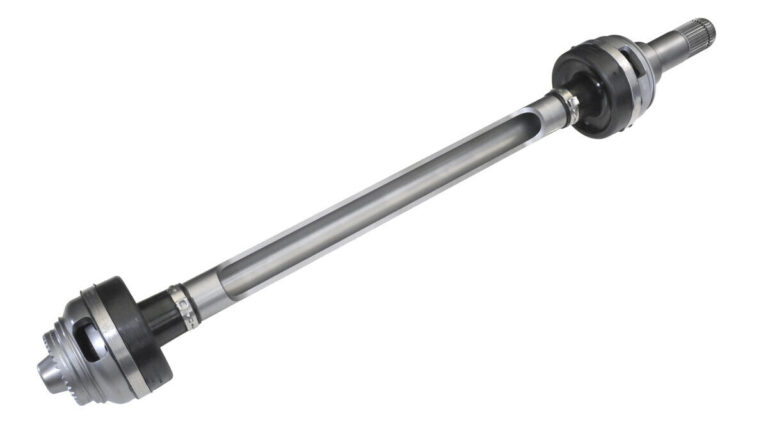As EVs evolve, sideshaft testing must keep pace with sophisticated techniques to guarantee top-notch performance, catering to the unique torque and speed demands of electric powertrains, according to Jens Langrehr, chief engineer for physical testing at GKN Automotive
The introduction of electric vehicles has triggered an evolutionary step in testing which, combined with the shortened lifecycles of OEM products, requires faster, more flexible and reliable testing capabilities. Suppliers have had to adapt test processes and procedures to address the distinct functional conditions of multiple electrical platforms. Due to the increased and more dynamic power delivery, together with recuperation, the driving profiles have had to be reevaluated and redesigned in conjunction with the ambient and environmental conditions.
Three key differences between EVs and combustion engine vehicles can be identified. The first is weight, with EVs around 1.5 times heavier than their ICE counterparts. This puts more strain on the components and lowers the center of gravity of an EV. As such, EV sideshafts are significantly shorter, requiring different mounting points and larger installation angles.
The second difference is that EVs have higher torque and improved acceleration loads, as well as the need to maximize energy recuperation during braking. This means components must withstand higher torques and more aggressive torque gradients under acceleration. As a result, EV sideshafts must be stiffer and more robust, to handle such tough torque demand over a wider power band.
EVs have a very different topography from a combustion vehicle, the minimal surrounding of the motor, which is necessary due to heat dissipation, means that potential noise and vibration emissions are amplified and more susceptible to ingress into the cabin.
This leads us to the third differentiator: these noise, vibration and harshness concerns are becoming more critical, requiring newer, more demanding validation processes to assess the performance of sideshafts, such as the squeal of stick-slip noise.
It is essential, therefore, for suppliers to adapt testing processes and standards to address these new requirements during the various development phases. Beyond the changing validation requirements for products, OEMs are also increasingly seeking to reduce and optimize the vehicle validation phase, and we’re seeing growing demand for real-time testing. Most of these conditions are based on road-load data extracted from in-vehicle sensors, but we are also seeing the use of synthetic data generated by virtual vehicle models.
Over the past years we have continuously monitored and analyzed the evolution of these changes and their impact on the validation needs of sideshafts. We have continued to expand and enhance our testing capabilities to reflect these advances. While on some occasions it has been possible to adapt existing equipment, for the most part we’ve developed new state-of-the-art sideshaft test rigs in partnership with our suppliers.
We have enhanced a range of our test capabilities, including torque capacity and speed, as well extreme climatic tests, which can affect functional, strength, endurance and NVH specifications.
Robustness and fast response times of the test bench actuators are essential due to the very high torques, such as the dynamic strength tests above 8,000Nm and gradients ±50,000Nm/s required in endurance real-time runs. These values push mechanical systems to their limits, which is why the new test rigs are increasingly turning to electromechanical and electromagnetic actuator solutions.
We have the ability to create ‘damage’ procedures that replicate vehicle conditions, without having to physically drive the vehicles. We can create very demanding test programs to allow us to carry out accelerated endurance tests, covering up to 300,000km in just four to six weeks, depending on customer requirements.
This strategy has the advantage of providing accurate and repeatable results while saving unnecessary testing effort. Additionally, it enables us to replicate very specific vehicle events in a controlled and repeatable environment, allowing us to evaluate the optimum solutions while producing quicker product validation.
For many years, we have been working to develop the appropriate virtual tools, translating the results into empirical data. We are applying some of the latest techniques around artificial intelligence (AI) and machine learning (ML), taking advantage of the large and diverse historical data we have generated when validating new products and applications, to improve the accuracy and prediction of our tools.
To ensure reliable and accurate results, however, we’ve correlated the results obtained through virtual tools against real-world vehicle test conditions. The test data generated by the new test procedures, being closer to real vehicle test conditions, allows us to further improve and fine-tune our predictive virtual tools.
This not only significantly shortens the validation phase, as required by our customers, but also reduces development costs by the OEM, as well as improving how sustainably we validate new vehicles. We minimize unnecessary waste and energy consumption by reducing the number of physical test activities and, consequently, the production vehicles required.
The automotive industry is currently at a crucial moment with the introduction of EVs, which has been boosted by the incredible progression of virtual test capabilities and the introduction of AI. We are addressing this with a holistic plan, ensuring we remain at the forefront by providing the best test data and validation to our customers, in the most efficient manner.


